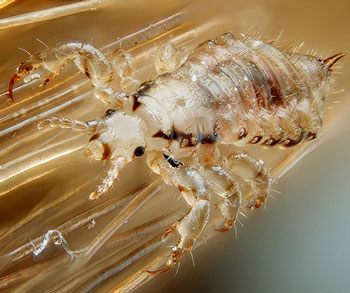In the News – It’s Getting Harder to Kill Head Lice
By Chris Williams on April 11, 2014.
 If you have a child in school, this news item could impact you. If you have a child in school who has head lice, then you should really pay attention.
If you have a child in school, this news item could impact you. If you have a child in school who has head lice, then you should really pay attention.
Decades ago, the standard (and really the only) insecticide treatment for head lice was a shampoo, available only by prescription. But in the early 1990’s, over-the-counter louse shampoos containing pyrethroid insecticides like permethrin became available. Permethrin products like Nix have been used widely for many years against head lice which has resulted in insecticide resistance. That means that head lice are no longer affected by permethrin. It didn’t happen overnight. Significant resistance to permethrin from head lice was being reported in 2000.
A study in the U.S. and Canada found that more than 88% of the lice sampled carried a mutation that makes them resistant to standard over-the-counter permethrin treatments. Newer studies suggest close to 100% resistance of head lice to permethrin. In the news they’ve been dubbed “Super Lice.” Changing over-the-counter lice products doesn’t help if they all contain permethrin as the active ingredient. A different product name doesn’t mean a different insecticide.
How Does Resistance Develop?
Resistance to an insecticide develops when a few insects manage to survive exposure to the insecticide. When these survivors mate, they pass on that ability to overcome the insecticide to their offspring. Through time, more and more of the population becomes resistant to the insecticide which eventually loses its ability to control the pests.
Unbeknownst to the manufacturers of the permethrin products, head lice were already carrying the makings for permethrin resistance as a result of their ancestors’ exposure to DDT. When people were treated for body lice with DDT almost 70 years ago, head lice were exposed as well. Surviving lice developed a mutation that granted them a cross-resistance to permethrin. The reason the permethrin resistance is tied to the DDT resistance is that both insecticides have the same mode of action, or method of killing, which affects the insect’s nervous system. Resistance develops most rapidly when insects are exposed to the same insecticide, or to related insecticides with the same mode of action, for generation after generation.
The good news is that in the last few years, a few new head lice products have become available, including Ulesfia, Sklice, and Natroba. Each has a different mode of action which offers more control options. The bad news is that these products are available only by prescription and are not over-the-counter products like permethrin. They have an advantage, though, in that they each require only one application. The older permethrin products required repeated applications.
[Source: “Head Lice Growing Resistant to Standard Meds,” Alan Mozes, HealthDay News, March 14, 2014]
Photo credit: Gilles San Martin / Foter / CC BY-SA 2.0